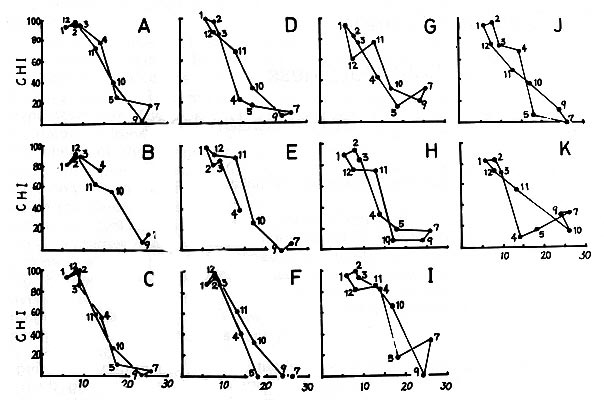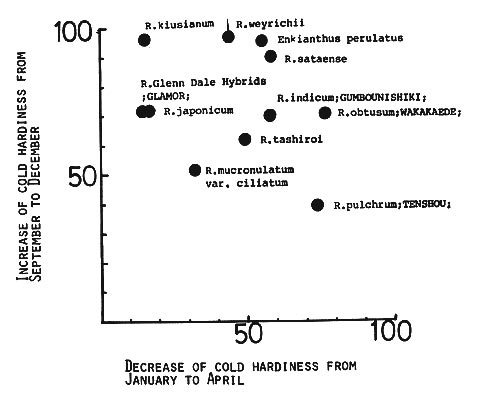The Seasonal Change of Cold Hardiness in Rhododendrons
Satoshi Yamaguchi, Fukuoka, Japan
Research Scientist, Dr. Agr. Laboratory of Ornamental Crop Breeding, Kurume Branch,
Vegetable and Ornamental Crops Research Station, Mii-machi, Kurume, Fukuoka, Japan
The seasonal change of cold hardiness index (CHI) of rhododendrons was investigated at monthly intervals from autumn of 1978 to summer of 1979. Investigated plants were as follows;
Rhododendron kiusianum
, Glenn Dale hybrid 'Glamor',
R. weyrichii
,
R. mucronulatum
var.
ciliatum
,
R. sataense
,
R. obtusum
'Wakakaede',
R. indicum
'Gunbounishiki',
R. japonicum
,
R. tashiroi
,
R. pulchrum
'Tenshou', and
Enkianthus perulatus
.
CHI value is calculated using the EC value of electrolytic leakage from (1) intact, (2) frozen, and (3) boiled twigs (1 g), as thus, (3) - (2) / (3) - (1) (%). As for (1), twigs were immersed into water (50 ml) for 16 hours. As for (2), twigs were sown in a cold chamber (-20° C) for six hours, and after it, immersed into water (50 ml) for 16 hours. As for (3), twigs were directly dipped into boiling water (50 ml) and left for 16 hours without further heating. All experiments were repeated three times, and the averaged value was adopted.

|
|||||||||||
| Fig. 1 Monthly change in CHI values and mean temperature in several selected rhododendrons. | |||||||||||
|
CHI values of all plants increased when mean temperature decreased to about 15° C (Fig. 1). But, the increasing velocity of CHI varied among them. Most rapid increase of CHI to the maximum value was observed in
R. kiusianum
, Glenn Dale hybrid 'Glamour',
R. weyrichii
, and
Enkianthus perulatus
. On the other hand, rather dull increases of CHI were observed in
R. pulchrum
'Tenshou',
R. tashiroi
, and
R. mucronulatum
var.
ciliatum
. CHI values of all plants reached plateau before January, when the mean temperature was below 10° C. CHI value of almost all plants reached 100% during winter, but that of
R. pulchrum
'Tenshou' hardly reached it.
The de-hardening velocity was more variable than that of hardening.
R. kiusianum
and Glenn Dale hybrid 'Glamour' maintained the highest CHI value for four months during winter. On the other hand, those of
R. pulchrum
'Tenshou' and
R. obtusum
'Wakakaede' decreased rapidly during February to March. Immediately before blooming and at the beginning of elongation of spring shoots, CHI values were very low in all plants. The scatter diagram for correlation between gain and loss of CHI values clearly proves that
R. kiusianum
is the most hopeful species for the breeding of cold hardy rhododendrons (Fig. 2).

|
|
Fig. 2 Scatter diagram of gain and loss of CHI
values in several selected rhododendrons. |
Rapid gain and slow loss of cold hardiness are most desirable natures for hardy plants in our garden, I think. Then, R. kiusianum , Glenn Dale hybrid 'Glamour', and R. japonicum will meet those requests at present. R. pulchrum 'Tenshou', in spite of its very handsome flower with bright red color, may be used for gardening only in the southern area of Japan because of its less hardiness. We will be able to develop the breeding of cold hardy evergreen rhododendrons using R. kiusianum as one of promising parents.